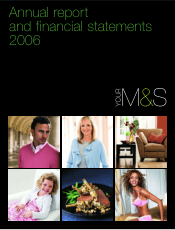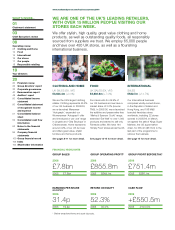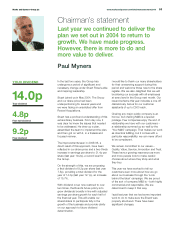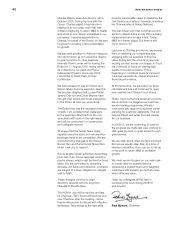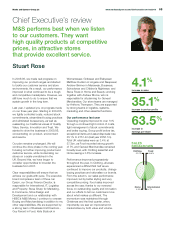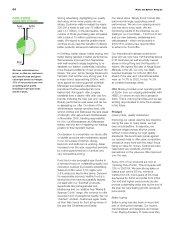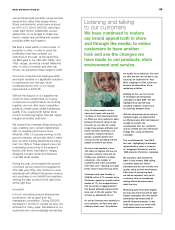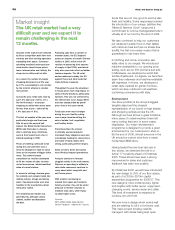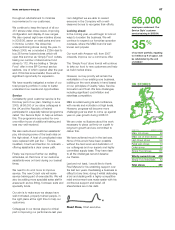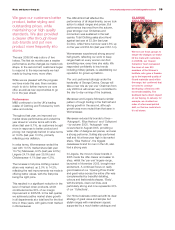Marks and Spencer 2006 Annual Report Download - page 7
Download and view the complete annual report
Please find page 7 of the 2006 Marks and Spencer annual report below. You can navigate through the pages in the report by either clicking on the pages listed below, or by using the keyword search tool below to find specific information within the annual report.
05Marks and Spencer Group plc
use and share best practices, as we become
demand-led, rather than supply-driven.
Stock commitments, which were reduced
by 35% or £1.3bn in 2004/05, were kept
under tight control. Additionally, we set
aside some of our budget to chase new
trends, missed opportunities and popular
products within each season.
We kept a close watch on the number of
products on offer, in order to avoid the
proliferation that has confused our
customers in the past. At the same time,
we filled gaps in our offer with ‘Petite’ and
‘Plus’ ranges, as well as a small ‘Maternity’
offer. In order to broaden and offer real
choice, we will extend these ranges in 2006.
Our focus on stocks and catalogue width
and depth resulted in a significant reduction
in markdowns over the year, which
contributed some 50% of our margin
improvement in 2005/06.
Without the support of our suppliers we
could not have transformed our buying
or improved our performance. By working
together, we now offer more competitive
prices at a faster pace, whilst maintaining
quality. This, coupled with tighter stock
control, is achieving higher volumes, higher
margins and better cash flow.
We opened five overseas offices during the
year, enabling us to cement relationships
with our suppliers and source more
efficiently. With 120 people working on the
ground overseas, we are also able to make
sure our strict trading standards are being
met. Our office in Turkey played a key role
in speeding up sourcing of the season’s
trends, with some ‘fast fashion’ ranges
designed, bought, made and delivered
in as little as six weeks.
During the year, we increased the amount
of product we buy direct from suppliers to
25% (last year 20%). We continue to work
extensively with efficient full-service vendors,
who purchase on our behalf from suppliers,
offering the right product at the right price,
at the right time.
Innovation
In Food, innovative product development
continues to set us apart from the
mainstream competition. During 2005/06,
we began to do this on a scale we have not
achieved for many years. We listened to our
customers who are increasingly demanding
Listening and talking
to our customers
We have continued to restore
our brand appeal both in store
and through the media, to entice
customers to have another
look and see the changes we
have made to our products, store
environment and service.
Over 15 million people visit our
stores each week, with around
10 million of them purchasing from
us. While our core customers, aged
between 35 and 55, remain a key
focus for us, we cater for a wide
range of age groups, attitudes and
tastes. We listen carefully to our
customers, using formal focus
groups, customer panels and
surveys as well as talking with the
people we meet in our stores.
We have used counters in over
160 stores to improve the way we
measure customer visits and are
trialling new software to analyse
conversion – the number of
customers who make a purchase
when they visit – allowing us to plan
better service levels for busy times.
Customer visits rose steadily in
2005/06, with a 4.7% increase since
Christmas, against an overall market
decline of 7%. Our analysis shows
that conversion is lagging behind
this growth although improvements
were seen in the last quarter. This
remains an opportunity for us.
As well as listening more carefully to
our customers, we have also been
talking to them more. To underline
the quality of our products, the value
we offer and the care we take in our
sourcing, we launched the ‘Your
M&S’ campaign in 2004, which has
become an umbrella for all our
marketing activities.
Building on this, we ran a series
of newspaper and broadcast
campaigns in April 2005. The first
highlighted our special food,
including ‘Oakham’ chicken and
our specially blended wines.
With the introduction of our autumn
clothing ranges, we believed that
our Womenswear offer had improved
enough to warrant new
consideration from our customers
and we created our now well-known
Twiggy, Erin, Laura and Noemie
campaign.
This was followed by ‘Your M&S
for Less’, highlighting the dramatic
improvement in value; a re-launch
of ‘Autograph’ Menswear; and the
‘M&S presents Christmas’ campaign.
We launched ‘Look behind the
label’ in late January 2006, telling
customers about our ethical
standards and the care we take over
quality, safety and the environment.
After years of pioneering work,
we had an important story to tell
customers who are increasingly
making ethical decisions about
what they buy.
Marketing spend increased slightly
but was also more focused on high-
impact campaigns. Not only did the
advertising help boost sales of
specific featured products, it also
lifted sales across our whole offer
and boosted brand perception.

